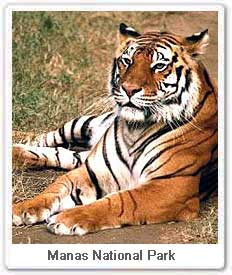Major Attractions : Tigers, Rhinos, Elephants.
Area Coveredrea : 391sq-km.
Ideal Time to Visit the Park : During the months of November to April.
Nearest Attractions : Hajo, Pabitora, Bhalukpung.
Some Major Accesses : Guwahari (176 km), Tezpur.
Things to Know
Where is the Manas National Park
Manas National Park in Assam is situated on the foothills of the Himalayas and a portion of it stretches to Bhutan (the neighbouring Princely State).
 Important
Dates in Manas' History
Important
Dates in Manas' HistoryThe Assam Manas National Park was declared a sanctuary on October 01, 1928 and was designated a World Heritage site in December 1985.
The Ecological System in the Manas National Park
The physiology of the rehabilitation park is mostly small meadows located among densely forested foothills with many rivulets, streams and natural drains flowing all around. The park is mainly watered by the river Manas, which also forms the international boundary between India and Bhutan. In the low lands, there are many smooth sandy expanses with clumps of trees growing in, and around, them.
The Flora in the Manas National Park
The vegetation that covers most of the park is of the mixed deciduous variety. This mixed forest is intermixed by small glades of grass where deer can be seen grazing in huge numbers. Altogether, Manas National Park Assam offers some of the most eye-pleasing natural surroundings in the country.
The Fauna in the Manas National Park
The animal population of Manas National Park Assam is very diverse. Some of the more fierce or potentially aggressive creatures it holds within it's confines are Tigers, Elephants, Rhinos, Wild Buffaloes, Leopards, Clouded Leopards and the amazingly beautiful and rare Black Panthers. The park is also a haven for highly endangered species of which it houses 20. Two of the unique residents of the park are the Hispid Hare and the Pygmy Hog.
Some of the other animals sighted while exploring the park are Gaurs, Swamp Deer, Capped Langurs, Golden Langurs, Assamese Macaques, Slow Loris, Hoolock Gibbons, Smooth Indian Otters, Sloth Bears, Barking Deer, Hog Deer, Sambar and Chital
The Avifauna in the Manas National Park
Manas National Park in Assam is a favourite with many bird species, resident and migratory. Some of these are Giant Hornbills, Red Jungle Fowls, Bulbuls, Brahminy Ducks, Khaleej Pheasants, Egrets, Pelicans, Fishing Eagles, Serpent Eagles, Falcons, Scarlet Minivets, Comb Duck, Bee-Eaters, Magpie Robins, Pied Hornbills, Gray Hornbills, Mergansers, Harriers, Ospreys and Herons.
The Safaris in the Manas National Park
The Jeep, Elephant and Boat Rides
The ideal way to explore a majority of the Manas National Park in Assam is in a 4-wheel (Jeep) drive petrol vehicle. The Jeep ride will get you to all the corners of the Manas Park without being too noisy. Some of the animals that comes out on the banks of the river Manas can be viewed from a boat which commences its ride from Mathanguri and ends around 35km away, from where one is picked up by pre-arranged transport. The third option, which are a favourite with most visitors, are the elephant rides organised by the park authorities from Mathanguri. These take you deep in to the densest areas of the forest and often right in between some of the wildlife there, including elephants, rhinos and wild buffaloes.
Manas Tiger Reserve Travel Circuit
Kolkata - Manas - Kaziranga
How to Reach Manas National Park
Air : Manas National Park is 176 km from Guwahati. The nearest airport is Borjhar, which is situated, 5 km out of town, and can be reached by rickshaw, auto rickshaw or airline buses.
Rail : The nearest railhead is situated at Barpeta road.
Road : Buses regularly ply from Guwahati to Barpeta Road in 4½ hrs.






